When you want to build a VMware vSphere Lab at home, Intel might have a great system for you: The Intel NUC family - The Next Unit of Computing. The system was initially designed to be used as home theater or digital jukebox. Due to it's power it is also a fully adequate replacement for a desktop computer. The Intel NUC is big on performance and surprisingly small in size and power consumption and thus makes it a great candidate for a virtualization home lab.
The Intel NUC System is available as system board only and with a chassis. Currently there are 4 models available, beginning with an Intel Celeron processor and ending with a powerful Intel Core i5 vPro processor:
- DC53427HYE Kit / D53427RKE Board: 3rd gen. Intel Core i5-3427U (up to 2x 2.80 GHz)
- DC3217IYE Kit / DC33217GKE Board: Intel Core i3 3217-U (2x 1.8 GHz)
- DC3217BY Kit / DC33217CK Board: Intel Core i3 3217-U (2x 1.8 GHz)
- DCCP847DYE Kit / DCP847SKE Board: Intel Celeron 847 (2x 1.10 GHz)
Features
The Kits are shipped with:
- Chassis
- System board
- Processor
- External Power Adapter
- VESA Bracked
To get an ESXi Host installed you need:
- Memory (SO-DIMM DDR3)
- AC Power Cord (C5)
- mSATA SSD or USB-Stick
Model comparison
| DC53427HYE Kit D53427RKE | DC3217IYE Kit DC33217GKE | DC3217BY Kit DC33217CK | DCCP847DYE Kit DCP847SKE | |
| Form factor | UCFF | |||
| Processor | Core i5-3427U | Core i3 3217-U | Core i3 3217-U | Celeron 847 |
| Clock Speed | 1.8 GHz (2.8 max) | 1.8 GHz | 1.8 GHz | 1.1 GHz |
| Cores | 2 | 2 | 2 | 2 |
| HT | YES | YES | YES | NO |
| Max Memory | 16 GB | 16 GB | 16 GB | 16 GB |
| Network | 1x 1Gb Ethernet | 1x 1Gb Ethernet | 1x 1Gb Ethernet | 1x 1Gb Ethernet |
| Ports | 1x USB 3.0 2x USB 2.0 2x USB2.0 (int.) | 3x USB 2.0 2x USB2.0 (int.) | Thunderbolt 3x USB 2.0 2x USB2.0 (int.) | 3x USB 2.0 2x USB2.0 (int.) |
| Intel VT-d | YES | NO | NO | NO |
| VT-x with EPT | YES | YES | YES | YES |
| AES | YES | NO | NO | NO |
| TDP | 17 W | 17 W | 17 W | 17 W |
HCL and ESXi 5.x Support
The system has hardware support for virtualization and a 64-bit capable CPU. Therefore it should be compatible to VMware ESX. The Intel 82579LM Gigabit Ethernet driver is not included in the ESXi Base Image, so you have to create a customized Image. This article explains how to do that: ESXi 5.x Installation on Intel NUC fails with “No Network Adapters”.
To clarify, the system is not supported by VMware (No HCL entry), so do not attempt to use this System in a productive environment. As a home lab, or a small home server it should be fine.
Tested ESXi Versions
- VMware ESX 4.0
- VMware ESXi 4.0
- VMware ESX 4.1
- VMware ESXi 4.1
- VMware ESXi 5.0
- VMware ESXi 5.1
- VMware ESXi 5.5
Delivery and assembly
The NUC is shipped in well designed box that plays the Intel jingle when you open it. The Box contains a short description how to open and assemble the components. The system is a little bit heavier than it looks and has a high build quality. The upside may be scratch-sensitive, so be careful with it (When you don't need it as an ESXi Host, you probably want to use it as a media center).
To assemble the memory, you have to remove 4 screws on the bottom. The assembly is really quick, it took about 5 Minutes to open it, install the memory modules and close it. I also gave mine a SSD to leverage the new vSphere 5.5 features.
Setup
The system does not have a remote access card, so you have to install it with PXE or by CD. I burned my customized ESXi ISO and used a USB-CD drive to install the NUC. When you have the proper drivers installed, the installation should succeed without problems. I used an old 2GB USB Stick for the installation. Of course, you need some external shared storage for your virtual machines, but i assume that you have that anyway when you are playing with ESXi. 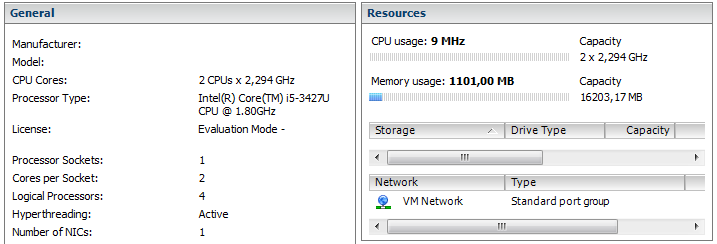
Power consumption
Standby: 4W
Idle: 25W
Peak: 47W
My setup with 3 Linux and one Windows Server averages at about 35W and is up 24×7. With that, the operating costs are at about 6 Euros per month:
35 watt * 24 h * 30 (days) = 25,2 KWh * 0,25 (EUR) = 6,30 EUR
Consumption measured with Voltcraft Energy Monitor 3000
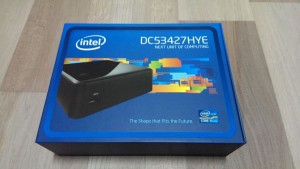
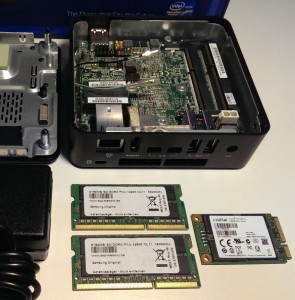
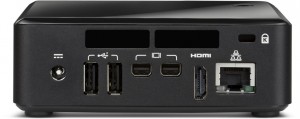
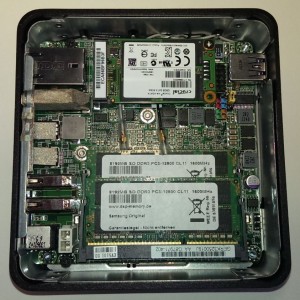
How log does it take to boot the NUC with ESXi?
90 seconds from power-on to login screen.
Am I missing something? It comes with 16GB of ram but you purchase more?
No, it comes without memory. 16GB is maximum supported.
Curious, the i5 model has memory listed, maybe it is just bad wording. Thanks for the guide
Did you have an issue during boot up (after installation) where you needed to press F10 and select the internal storage (mSata) to get the system to boot?
No, never saw that. Did you change the boot sequence?
I am having this exact issue. If I hit f10 and startup and select the only boot device there, the internal msata drive, everything is fine. When I just let it startup without interacting, it attmpts to download an image across the network to install on the machine. I'm going to play a little more with the bios but have it set as I think it should be.
Correction, with just msata enable, I get "A bootable device is not detected..." even though hitting f10 and selecting it works.
You need to enable UEFI boot.
I finally got esxi5.1 to load on the Haswell NUC, but only if I install it on a USB stick - ESXi doesn't recognize the interal mSata. I know the NUC sees the mSata - I installed Windows 2012 on it - so it's functional - just not in ESXi.
Any idea how to add driver support for the Haswell NUC mSata controller to ESXi (I used the customizer).
By the way - Andreas Peetz hooked me up (and i'll dontate to his excellent effort) and found me an ESXi driver that I installed using the customizer - it does indeed support the i218-V :
http://shell.peach.ne.jp/aoyama/archives/2907
"net-e1000e-2.3.2.x86_64.vib"
Hi Zip,
Have your got the mSata drive working in ESXi or?
Yes, i got excellent help from Andreas Peetz at http://www.v-front.de and his amazing website. But i'm a hack and i dont think i can tell you how to do it... Other than you need to create a custom install for both the NIC and the SATA controller for this NUC...
NIC - ESXi driver that claims to support the i218-V on a japanese site here:
http://shell.peach.ne.jp/aoyama/archives/2907
SATA - http://www.v-front.de/2013/11/how-to-make-your-unsupported-sata-ahci.html.
Good luck
Hi,
Did you managed to get the remote KVM working? This is the model I have and I selected the 3427 one for this reason. I can access the Intel AMT tool which provides some basic tools, but can't access the out-of-band console screen. I'd love to hear how you got on.
Forbes
Hi Forbes,
yes the remote KVM is working but you need some tools from Intel. Not sure where you stuck, this is what I did to get it working:
1) Power on the NUC, go to the MEBx Bios (CTRL+P)
2) Set a Password
3) I did not change anything else. The Webinterface should be available now (http://IP:16992/)
4) Download and install Manageability Developer Toolkit Binary: http://download-software.intel.com/sites/default/files/m/d/3/3/4/b/45735-ManageabilityDeveloperToolKit.msi and RealVNC http://www.realvnc.com/download/viewer/ (RealVNC is optional)
5) Open Manageability Commander Tools (Comes with the Manageability Developer Toolkit)
6) Press "Add known Computer" and enter the IP address / login credentials
7) Press "Connect"
8) Go to Remote Console Tab
9) Enable Remote Control and press "Take Control"
If you get a blinking cursor, try "Remote Control" > "Remoted Reboot"
Has anyone had issues with PSODs on their NUC after installing ESXi? I am running a Windows 2008 DC guest, a Windows 7 guest, and the vCenter appliance. Every so often I am getting a PSOD. Here is my hardware:
1 x DC3217IYE Kit (Intel Core i3 3217-U)
1 x Mushkin Direct Atlas Deluxe 120GB mSATA SATA III Solid State Drive MKNSSDAT120GB-DX
2 x G.SKILL Ripjaws Series 8GB 204-Pin DDR3 SO-DIMM DDR3 1600 (PC3 12800) Laptop Memory Model F3-1600C9S-8GRSL
1 x Synology DS211 - iSCSI datastore - guests stored here
Any help is appreciated.
Regards,
Dan
mine works great with 5.1 on 3rd gen NUC, the latest customizer app doesnt appear to ake a valid iso of 5.5 with 3rd gen nic drivers. Any ideas?
You can also use PowerCLI Image Builder to create a custom ISO.
When you have a running ESXi 5.1, just do an update to 5.5.
Hello,
Thank you for sharing your experience. Nice site!
Have a question, was you able to find the way to monitor Hardware - Health Status from NUC: fan, voltage, temperature... (as i understood, vmware is using cim providers, but was not able to find more info for NUC)
How is the performance of ESXi on the NUC? Or in other words: is the i3 CPU powerful enough to host more than 8 VMs?
Depends on your workload. I think ~6-8 VMs should be okay. You are also limited to 16GB memory.
HelloWWW, thanks for the info here all. I had no idea that the DC53427HYE has the KVM feature. Sweet! I was having hard time pitching NUCs lab boxes since they had no kvm on the other models. Also, heads up that the table above comparing models has a major mistake: the red-topped box with the thunderbolt has NO on-board GBE. Adding via thunerbolt is ok so long as you don't need PXE. Finally, I have crashed some 'nix pulling out a thunderbolt, so be careful with that red box...
@Meh, do you have any details on how you got the thunderbolt up and running. I've tried ESXi 5.1 and 5.5 with no luck. 5.1 reports no network adapters and 5.5 hangs at "Loading imgpayld.tgz".
Any tips appreciated!
Pingback: Preparing for the VCAP-DCA exam - Virtual Elephant
Thanks for that articles, Do you please know how to had Hard drive connect through USB on the datastore of esxi ? and also my second SSD which is not recognize by esxi?
You can't use an USB HDD as VMFS datastore.
How does this run overall? I'm mulling over combining several boxes into a vSphere box for power saving possibilities. I'm wondering if I could combine my Plex, Asterisk and file server all into the one box.
I'm running exactly that combination of services on an Ubuntu VM on my NUC. It works great. I'm sure you could run them as separate machines if you wanted to.
Love your site - great tips, thank you! I'm having an issue with 5.5 and nuc D54250WYK. Used your custom build and installed to 8GB USB. NUC boots fine and gets IP thru DHCP or can set static but can't ping out or ping to this box. Anyone have this issue? Tried the nete1000e-2.3.2 and 3.1.0.2 versions - same results with both. :???:
Pingback: Running Nested ESXi / VSAN Home Lab on Ravello | virtuallyGhetto
Hello Virtenians,
I wonder if fgrehl could make a little manual to change the default configuration from one network, to two independant networks.
I was searching on internet how to separate/isolate the physical networks. One to the normal process and other to connect the NAS.
For example, my default home network: 192.168.1.1/24 and the internet connection.
The NAS network 10.0.0.1/24 (sure, i don't want to be able to connect to the NAS from my other net)
Today I was testing on the VMKernel NIC and discover it, but i waste too much time.
Do you mean how to add a second vmknic with VLAN tagging?
Uhm... not, vlan tagging not, maybe not.
But is possible that my question will have no sense.
So...
I have 4 computers and the esxi in the same network 192.168.1.x (esxi 192.168.1.5-vmk0)
Also i have a NAS with VMs at the network: 192.168.1.4
I want to change the IP for the NAS to 10.0.0.4, so the computer can't access it directly.
But i want to add a second network 10.0.0.5 to the esxi to continue using NSF to access the virtual machines at the NAS (10.0.0.4)
I was trying to create a new VMKernel NIC(vmk1), and adding two USBCards and bond it to the esxi.
I want to have the vmk0 to access the VMs from the computers and the vmk1 only to acces the NFS system from the NAS.
But at the end i mess up all the esxi configuration and begin to raise to many errors.
So finally i disconnect the USB Networks cards and delete all, VMKernel, vSwitch and rollback IP adresses.
My question:
Is it possible to have two separate networks inside the esxi?
I think i found my answer in other thread.
http://www.virten.net/2015/09/adding-a-second-nic-to-a-5th-gen-intel-nuc-or-other-pcie-cards/
"There are USB NICs in the market, but for ESXi hosts they only work in path through mode. That means that USB NICs can only be used inside VMs and not for the hypervisor itself as vmnic."
So i can't separete isolate my NAS with the NFS... not in a easy way.
Thanks a lot fgrehl
Meanwhile you can also use USB NICs in ESXi: http://www.virten.net/2016/06/additional-usb-nic-for-intel-nucs/
Yeah, thats my bible's thread to install USB Nics.
Thanks you so much again.
Hi all,
is this nuc DC53427HYE works with ESXi 7?
Needs customized image?
Thanks